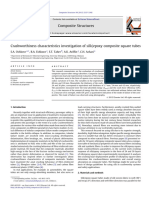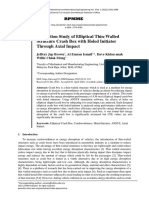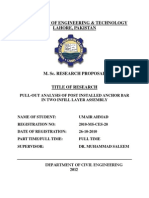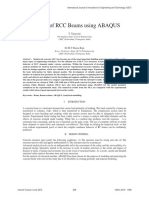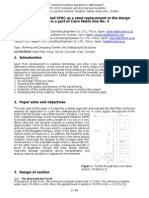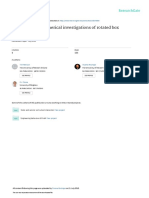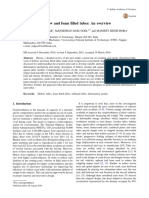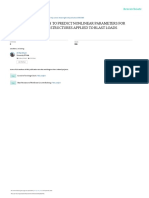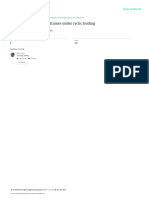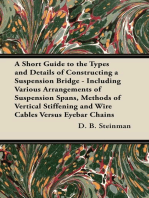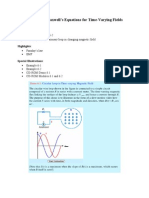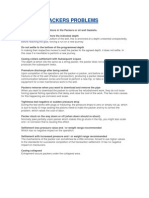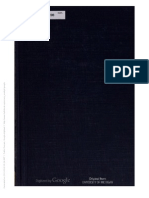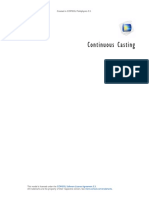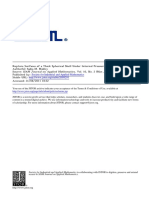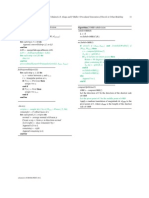663 Ea0076
663 Ea0076
Uploaded by
anon_629908933Copyright:
Available Formats
663 Ea0076
663 Ea0076
Uploaded by
anon_629908933Original Description:
Original Title
Copyright
Available Formats
Share this document
Did you find this document useful?
Is this content inappropriate?
Copyright:
Available Formats
663 Ea0076
663 Ea0076
Uploaded by
anon_629908933Copyright:
Available Formats
IACSIT International Journal of Engineering and Technology, Vol. 6, No.
1, February 2014
Axial Crushes Simulation of Double Thin-Walled Metallic
Structure Inserted with Polymeric Foam
A. Othman and Azrol Jailani, Member, IACSIT
maximization of the deformation. There are several remedies
and design criteria which can be followed if the goal is to
increase the crash resistance to a lateral impact, such as
strengthening the rocker section and the floor pan (e.g. with
high-strength steels, internal baffles and rigid foam fillings),
to help transfer [6]. In this study, Fig. 1 and Table I illustrated
and showed finite element model and dimension of various
cross-section tubes including type of arrangement of double
cell. The objective in this study were to determine and
investigate the dynamic energy absorption of various
cross-section of polyurethane foam filled titanium alloy
under axial loading using finite element commercial
softwares of ABAQUS [8]. In this study also were carried
out the variable of velocity dynamic loading and
wall-thickness in order to identify the influence of
crashworthiness characteristics.
AbstractThe paper deal with numerical studies of dynamic
axial loading of thin-walled metallic titanium alloy extrusion
double cell polyurethane foam-filled square. Nonlinear dynamic
simulations were performed on empty as well on foam-filled
modeling. The dynamics non-linear finite element code
ABAQUS standard and explicit were used to simulate the
buckling and crushing of columns. The influence of filler
material on energy absorption and behavior of double cell
thin-walled square metallic titanium alloy extrusion were
examined. Three main collapse modes were identified for the
crushed model, such as compound diamond asymmetric,
concertina axisymmetric and mixed mode fold formations.
Three different arrangement of double-cell inner column were
examined and investigated. Filling the polyurethane foams into
tubular double cell played important factor positively
influencing the energy absorption capability. Results showed
that the tubular energy absorption capability was affected
significantly by varying of velocity impact and wall-thickness as
well as arrangement inner tube cross-section.
Index TermsFinite element modeling, double cell, axial
loading, energy absorption, foam filled.
I. INTRODUCTION
A vehicle crashworthy structure has been developed by
engineers and researchers around the world from two decades
until now as a purpose to improve vehicle safety during
collision event [1]-[8]. During the progressive collapse of
crashworthy structures it has an ability to protect the
occupants from severe injury in collision accidents, including
side impacts with other vehicles and roadside objects [1].
Side collisions are among the most dangerous car accidents
[2]. While in frontal and rear-end collision the occupant can
be well protected by deformation elements (crash boxes)
placed outside the occupant cell, there is no room for such
crush zones in bodys side [3]. For this reason the side body
of the car and the structural frame must be designed in order
to avoid excessive deformation. Strength and stiffness,
however, are not the only requirements for improving
resistance to side impacts: provided a sufficient amount of
kinetic energy, absorbed in an impulsive way by the impacted
vehicle, even the stiffer structure will plastically deform to a
certain amount [4]-[7]. Therefore, side structures must also
absorb a large amount of plastic deformation energy and,
unlike axial absorbers, find a compromise between the
minimization of the maximum transmitted load and the
Fig. 1. Finite element model of double cell.
TABLE I: DIMENSION OF FINITE ELEMENT MODEL OF DOUBLE CELL
II. FINITE ELEMENT MODELING
Manuscript received May 15, 2013; revised July 10, 2013.
A. Othman is with the Mechanical Engineering Department, Polytechnic
Port Dickson, KM. 14 Jalan Pantai, 71050, Si Rusa, Port Dickson, Negeri
Sembilan, Malaysia (e-mail: akbar.othman@gmail.com).
Azrol Jailani is with The Association of Ledang Community Youth, 152
Jalan Puteri 1/6, Bandar Baru Tangkak, 84900 Tangkak, Johor (e-mail:
azrol.jailani@yahoo.com).
DOI: 10.7763/IJET.2014.V6.663
To represent real progressive collapse events, the velocity
and time need to be suitable. Taking a = 196.2 m/s2 as the
benchmark since humans can only sustain 20 g of
acceleration, value of sufficient crushing time can be
obtained. The initial velocity (V) of the tube is set to be 6 m/s,
43
IACSIT International Journal of Engineering and Technology, Vol. 6, No. 1, February 2014
hence calculated value for crushing time; (t) was found to be
0.02 s. The other important parameter of representing
crushing event is boundary condition. In structural analyses,
boundary conditions are applied to those regions of the model
where there displacements or rotations are known. Such
regions may be constrained to remain fixed or may have
specified nonzero displacements or rotations. In this model
the ENCASTRE (V1 = V2 = V3 = VR1 = VR2 = VR3 = 0)
condition has been used where the top section of the tube is
constrained completely and thus, cannot move in any
direction also.
where, m is the crushed mass of the thin-walled tube.
III. MATERIAL MODEL AND PROPERTIES
Three types of models were analyzed in this study which is
type A, B and C with different arrangement of inner tube
profile and filling the foam between space of inner and outer
of tube profiles. Material of titanium alloy was used to
determine the crushing behavior and having of 60 60 mm
outer diameter arrangement with inner tube were 40 40, 40
40 mm, radius of rounded tube profile of 20 mm. the
wall-thickness of 1.0, and 2.0 mm were examined and
investigated. The foam-filled models were carried out from
two tubes having outer wall from the same material as empty
tube profiles as well as inner wall of tube. The inner tube has
varied with three different arrangements including 40 x 40
and rounded at 30 mm radius and 1.0 and 2.0 mm
wall-thickness but constrained at the same thickness as well
as outer tube thickness. All sections had a length of 150 mm.
The empty tube sections were tested as foam-filled tube
profiles only with the foam in between inner and outer tube
wall. Fig. 2 and Fig. 3 illustrates typical test model geometry.
In this study the velocity dynamic of impact was applied at 10
and 20 m/s axially onto the frontal crash flat plate analytical
rigid surface. The simulation, which normally is run as a
background process, is a stage in which ABAQUS/Explicit [8]
solves the numerical problem defined in the model.
ABAQUS/Explicit is a special-purpose analysis product that
uses an explicit dynamic finite element formulation. It is
suitable for short, transient dynamic events, such as impact
and blast problems, and is also very efficient for highly
nonlinear problems involving changing contact conditions,
such as forming simulation. The evaluation is generally done
interactively using the visualization module of
ABAQUS/CAE [8]. The visualization module, which reads
the neutral binary output database file, has a variety of
options for displaying the results, including color contour
plots, animations, deformed shaped plots, and XY plots.
4.E +09
NOMINAL STRESS (Pa)
4.E +09
3.E +09
3.E +09
2.E +09
2.E +09
1.E +09
TITANIUM ALLOY
0.E +00
0.00
0.05
0.10
0.15
0.20
0.25
0.30
0.35
NOMINAL STRAIN
Fig. 2. Nominal stress strain curve of titanium alloy.
Fig. 3. Nominal stress strain curve of polyurethane foam.
IV. RESULT AND DISCUSSION
All square foam-filled tubes profiles of this analysis test
series having a foam density than the square ones rather
showed local progressive damage, but not typically
progressive, deformation behavior, where the formation of
folds began at different locations, generally not in a
sequential manner. Furthermore, these element models
buckled extensionally with all folds moving outwards, which
is obviously caused by the presence of the foam core. The
extensional deformations are also evident from the dynamic
load compression displacement curves in Fig. 4 to 5, because
the load fluctuations are much more pronounced. Filling
polystyrene foam inside of the tubes was in general
accompanied by shorter wavelengths of the individual folds
which is holds true for all element model test series. Within
element model test series empty and foam-filled square tubes,
which were arranged in different ways, empty, foam-filled
The bottom section, however, is fixed in the horizontal
direction but is free to move in vertical direction (V1 = V2 =
VR1 = VR2 = VR3 = 0). The direction in which motion is
possible is called degree of freedom (dof), hence this model
only has a single degree of freedom. A mechanical,
concentrated force with a magnitude of 500 N was applied in
order to initiate the crushing process. The actual load
magnitude is not critical because ABAQUS [8] will report
buckling loads as a fraction of the applied load.The total work
done (W) during the axial crushing of the cones are equal to
the area under the load/displacement curve and is evaluated
as:
W Pds
(2)
NOMINAL STRESS (Pa) VERSUS NOMINAL STRAIN TITANIUM ALLOY
5.E +08
(1)
where, P is the force acting on the tube. Therefore the specific
energy absorption per unit mass, E is recognized as:
44
IACSIT International Journal of Engineering and Technology, Vol. 6, No. 1, February 2014
tubes, and arrangement with dimension of inner square tube
profile, were analyzed.
to overall buckling of the whole arrangements. All filled
element modeling that deformed locally began to buckle in an
extensional mode, but after the formation of some folds most
switched to an inextensional mode. The measured dynamic
loads versus displacement curves from Fig. 6 also clearly
display the effects of the change of deformation modes. The
foam-filled tube element model show a pronounced load
fluctuation during the load cycles, owing to the extensional
folding modes, which is followed by minor differences
between maximum and minimum loads due to the
inextensional buckling deformations of the extruded titanium
alloy tubes.
The gluing between filler and tubes of element model
obviously caused the lobes to be filled with polystyrene foam
for the most part almost of wall-thickness 1 and 2 mm square
tube. However, some breaking of the interface can also be
observed for these element models. It should be noted,
however, that the main reason for applying fiction coefficient
for these interaction surface of inner, outer and foam element
geometries model. Furthermore, the dynamic load versus
displacement curves reveal a distinct quasi-steady progress of
the crushing forces which is fluctuating around a more or less
constant value, provided that the average foam density is not
too high. The ascending slope of the force level of double cell
type of B seen in Fig. 6 which square inner profile of 40 x 40
mm, however, is due to the foam behavior itself. The
stress-strain curves of uniaxially compressed foam cores
shown in Fig. 6, indicate that for foams of largest volume and
maintain low densities no marked plateau region can be
characterized by more or less constant stresses, but rather a
region of constantly increasing stresses can be observed thus
corresponding with the measured dynamic load versus
displacement compression behavior of crush elements model
filled with foams of higher volumes. Fig. 6 showed that the
double cell type of C of the sectioned inner square tube of 30
30 profile. Noted that element model was crushed far
beyond the stroke length. Whereas the square inner and outer
element model rather tended to buckle inextensionally, a
typical extensional folding mode is apparent from the square
both of inner and outer crush elements of this test series.
DYNAMIC LOAD (N) VERSUS DISPLACEMENT (M)
30000
20000
15000
10000
5000
0
0
0.02
0.04
0.06
0.08
0.1
0.12
DISPLACEMENT (M)
[W-T 0.001m:V 10m/s]
[W-T 0.001m:V 20m/s]
[W-T 0.0015m:V 10m/s]
[W-T 0.0015m:V 20m/s]
[W-T 0.002m:V 10m/s]
[W-T 0.002m:V 20m/s]
Type A
DYNAMIC LOAD (N) VERSUS DISPLACEMENT (M)
30000
20000
15000
10000
5000
0
0
0.02
0.04
0.06
0.08
0.1
0.12
DISPLACEMENT (M)
[W-T 0.001m:V 10m/s]
[W-T 0.001m:V 20m/s]
[W-T 0.0015m:V 10m/s]
[W-T 0.0015m:V 20m/s]
[W-T 0.002m:V 10m/s]
[W-T 0.002m:V 20m/s]
Type B
DYNAMIC MEAN LOAD (N) VERSUS DISPLACEMENT (M)
30000
20000
15000
10000
5000
DYNAMIC MEAN LOAD (N) AND ABSORBED ENERGY (JOULE) VERSUS
DISPLACEMENT (M)
DYNAMIC MEAN LOAD (N)
0.12
DYNAMIC ABSORBED ENERGY (J)
4000
20000
DISPLACEMENT (M)
18000
3500
16041.9
Type C
Fig. 4. Dynamic (N) versus displacement (m) tubular of foam-filled profile.
The inner material profile in Fig. 6 which is 50 50 mm
was used inside the outer square filling with polystyrene
foam with 100 kg/m3 density. The typical progressive
buckling characteristics, which could be observed in most
numerical analysis of this test series of wall thickness 1 and 2
mm as well as variable dynamic impact loading of 10 and 20
m/s, are evident from the deformed elements shown in Fig. 6.
The type of A, B and C foam-filled tube square profile also
reveals the higher densification in the outer region of the
foam core due to a multiaxial state of compression illustrated
resulting from foundation effects of the foam with respect to
the profile. Global failure was observed only for the
foam-filled tube foam filled elements. This can be traced
back to global buckling of the slender inner profiles, leading
13887.7
14000
11886.6
10970.4
2500
10722.1
9668.98
10000
2000
8998.49
1620.71
8000
7225.21
6163.73
1375.43
721.438
4000 620.385
1592.81
1463.3
1590.71
7734.11
6840.72
1324.79
6137.01
1097.79
5231.9
903.156
1115.38
952.955
6000
3000
13304.6
11343.3
12000
15592.9
14706.4
15559.5
16000
1500
1177.72
1074.51
1000
783.784
693.549
619.509
533.087
500
2000
[V=20m/s]
[V=10m/s]
[V=20m/s]
[V=10m/s]
[V=20m/s]
[V=10m/s]
0
[V=10m/s]
0
[V=20m/s]
[W-T 0.002m:V 20m/s]
[V=10m/s]
[W-T 0.0015m:V 10m/s]
[W-T 0.002m:V 10m/s]
[V=20m/s]
[W-T 0.001m:V 20m/s]
[W-T 0.0015m:V 20m/s]
DYNAMIC MEAN LOAD (N)
[W-T 0.001m:V 10m/s]
DYNAMIC ABSORBED ENERGY (J)
0.1
[V=10m/s]
0.08
[V=20m/s]
0.06
[V=20m/s]
0.04
[V=10m/s]
0.02
[V=20m/s]
[V=10m/s]
DYNAMIC MEAN LOAD (N)
25000
[V=20m/s]
DYNAMIC LOAD (N)
25000
[V=10m/s]
DYNAMIC LOAD (N)
25000
Fig. 5. Dynamic absorbed energy (Joule) type of double cell type of A, B and
C foam-filled profile [Wall-Thickness = 1.0, 1.5 and 2.0 mm] (Velocity=10
and 20 m/s).
V. CONCLUSION
The test element results model presented here confirm that
the mass related mean load level may considerably be
45
IACSIT International Journal of Engineering and Technology, Vol. 6, No. 1, February 2014
improved by filling tubular members with polystyrene foam.
Provided that the plastic buckling behavior remains
characterized by local modes, essential enhancements were
obtained for all investigated shapes and dimensions. These
improvements may partly be traced back to the axial
compression of the foam cores themselves, but interaction
efficiency is also play a substantial role that the simple
estimates. With respect to the total energy absorption
capacity of a given crush element, however, improvements
are less pronounced. The reason for this is that the maximal
crushing distances, which may be utilized for energy
dissipation, reduce with increasing foam densities.
Nevertheless, improvements of the mass the investigation of
foam-filled tube arrangements revealed that these may be
preferable to empty analysis. It could be shown that
improvements are mainly due to the presence of the inner
profiles, which are in general more mass efficient than the
outer ones. Interaction effects are somewhat less pronounced
that for empty tubes. An analysis of interaction effects was
performed, which not only allowed to determine the relative c
influences of such effects onto the mean load levels but also
to and some explanations concerning the differences between
cross-sectional shapes and mono-and foam-filled tube
arrangements, respectively.
Type A
REFERENCES
[1]
[2]
[3]
[4]
[5]
[6]
[7]
[8]
S. Abdullah, A. A. Arifin, A. Othman, A. K. Ariffin, and N. A. N.
Mohamed, Crushing behavior of hybrid foam-filled pultruded
composite under quasi-static oblique loading, Advanced Materials
Research, vol. 664, pp. 649-653, 2013.
A. Othman, S. Abdullah, A. K. Ariffin, and N. A. N. Mohamed, On
the crushing behavior of foam-filled composite tubes under
compressive loading, Advanced Materials Research, vol. 337, pp.
479-488, 2012.
A. Jailani and S. M. Tajuddin, Mechanical properties of stirred sic
reinforced aluminium alloy: stir casting with different composition of
sic, blade angle and stirring speed, Advanced Materials Research, vol.
622, pp. 1335-1339, 2013.
A. Mamalis, D. Manolakos, M. Loannidis, P. Kostazos, and C.
Dimitriou, Finite element simulation of the axial collapse of metallic
thin-walled tubes with octagonal cross section, Thin-Walled Struct,
vol. 41, pp. 891900, 2003.
A. Jailani, S. M. Tajuddin, and A. Othman, Finite element modelling
of polymeric foam-filled aluminium 2024-T4 alloy tube under
dynamic axial loading, Applied Mechanics and Materials, vol. 315,
pp. 45-50, 2013
L. J. Gibson and M. F. Ashby, Cellular Solids: Structure and Properties,
2nd ed. Cambridge University Press, Cambridge, New York,
Melbourne. Gradinger, R.C., Kretz, R., Degischer, 1997.
A. Jailani, S. M. Tajuddin and H. Zulkipli, Dynamic energy
absorption of filament winding conical composite with different
orientation angle and low velocity, Advanced Materials Research, vol.
622, pp. 241-245, 2013.
Abaqus 6.10 Theory and UserS Manual, Providence: Hibbit Karlsson
and Sornesen Inc., 2010.
Akbar Othman is a lecturer of Mechanical
Engineering at Port Dickson Polythecnic. He received
his first degree in Mechanical Engineering from
Universiti Tun Hussien Onn Malaysia in 2006, then he
continued studies at Universiti Putra Malaysia (UPM)
in Structure and Design Engineering, leading to Master
degree. He is working on simulating crushing
performance of hybrid laminated material Tapered
Tubes under oblique loading conditions. He was awarded with a M. Sc.
degree in 2009. After that, his has been pursuing his Ph.D degree in
Quasi-Static and Energy Absorption Performance of Foam-Filled
Composite Tubes under Off-axis Loading at Universiti Kebangsaan
Malaysia, (UKM) in progress. This author became a member (M) of
IAENG, International Association of Computer Science and Information
Technology (IACSIT) and board of Engineer Malaysia (BEM).
Type B
Azrol Jailani is a member of IAENG (121660) and he
was born in Johor, Malaysia on 5th February. He got a
first degree in Mechanical Engineering with honors
from Universiti Tun Hussein Onn Malaysia in 2007.
He is currently pursuing studies in the same field in
postgraduate program at Universiti Tun Hussein Onn
Malaysia.
He is currrently an independent researcher at the
association of Ledang Community Youth, Johor,
Malaysia. Previously he had served in Ledang
Community College and Port Dickson Polytechnics, Malaysia as a lecturer.
He is interested in the field of materials science and many research he has
published into international journal.
Engr. Jailani is member of Institute of Engineers, Malaysia (28618),
Board of Engineers Malaysia (53480A), International Association
Computer Science & Information Technology (80344528) and Institute of
Materials Malaysia (4109). Paper Progressive Damage of Double-Cell
Square Aluminium 6061-T5 Alloy Polystyrene Foam-Filled Section gets
the best paper awards at 2nd. International Conference on Arts, Social
Sciences & Technology (iCAST2012), 3rd. 5th. March 2012, Penang,
Malaysia.
Type C
Fig. 6. Deformation pattern of double cell type of A tube profile
[Velocity=10m/s; Wall-Thickness = 1.0 mm].
Furthermore, some basic conditions for the appropriate
choice of tube filler combinations could be obtained this way.
Design considerations, pointing out the essential constraints
for the appropriate choice of foam densities for the
construction of mass efficient crush elements, have been
summarized. However, all considerations stated therein are
restricted to the behavior of dynamically loaded crush
elements, which are filled with polystyrene foam.
Furthermore, influences of gluing have to be investigated in
more detail, because they are expected to markedly influence
the energy absorption capacity of filled crush elements. With
respect to the design of `optimally tuned' composite crush
elements, numerical methods could also turn to account,
which allow to gain more insight into the mechanics of such
complex plastic deformation processes.
46
You might also like
- Wind Turbine AnalysisDocument10 pagesWind Turbine AnalysiststamaNo ratings yet
- Friction Coefficient of Steel On Concrete or Grout PDFDocument7 pagesFriction Coefficient of Steel On Concrete or Grout PDFLuis Ernesto Ramirez OsorioNo ratings yet
- Reinforced Concrete Buildings: Behavior and DesignFrom EverandReinforced Concrete Buildings: Behavior and DesignRating: 5 out of 5 stars5/5 (1)
- 43003Document9 pages43003Alireza EyvazzadehNo ratings yet
- Numerical Study of Reinforced Concrete Beam Subjected To Blast Loading Using Finite Element Package ABAQUSDocument4 pagesNumerical Study of Reinforced Concrete Beam Subjected To Blast Loading Using Finite Element Package ABAQUSJangdiniNo ratings yet
- Nonlinear and Experimental Modelling of Prestressed SCC Bridge GirdersDocument8 pagesNonlinear and Experimental Modelling of Prestressed SCC Bridge GirdersalexziotoNo ratings yet
- Anlysis of U Girder Bridge DecksDocument5 pagesAnlysis of U Girder Bridge DecksFadhilah Muslim100% (1)
- Oshkovr 2012Document6 pagesOshkovr 2012Sait Ozan YılmazNo ratings yet
- Iijme 2014 10 20 10Document6 pagesIijme 2014 10 20 10International Journal of Application or Innovation in Engineering & ManagementNo ratings yet
- Engineering Fracture Mechanics: SciencedirectDocument16 pagesEngineering Fracture Mechanics: SciencedirectMUIN ABDULLAH-ALNo ratings yet
- Tubular Stainless and Mild Steel Double-Skin ColumnsDocument6 pagesTubular Stainless and Mild Steel Double-Skin ColumnsIhab El AghouryNo ratings yet
- The Influence of Cross-Section Shape of The Car Roof Rail On The Quqsi-Dynamic Buckling ModesDocument8 pagesThe Influence of Cross-Section Shape of The Car Roof Rail On The Quqsi-Dynamic Buckling ModesKarthik KarunanidhiNo ratings yet
- Structure and Construction Examples of Tunnel Reinforcement Method Using Thin Steel PanelsDocument6 pagesStructure and Construction Examples of Tunnel Reinforcement Method Using Thin Steel PanelsMohamed H. JiffryNo ratings yet
- Energy TestDocument19 pagesEnergy TestDataNo ratings yet
- Ijciet 06 09 017 PDFDocument16 pagesIjciet 06 09 017 PDFIAEME PublicationNo ratings yet
- Comparative Study of Ultimate Load For Castellated and Plain-Webbed BeamsDocument11 pagesComparative Study of Ultimate Load For Castellated and Plain-Webbed BeamsgaganavinayNo ratings yet
- Effects of Opening On The Behavior of Reinforced Concrete Beam I011275261Document10 pagesEffects of Opening On The Behavior of Reinforced Concrete Beam I01127526101010No ratings yet
- Experimental Investigation On Seismic Resistance of Recycled Concrete in Filled Steel Columns - Taguchi's ApproachDocument9 pagesExperimental Investigation On Seismic Resistance of Recycled Concrete in Filled Steel Columns - Taguchi's ApproachMuchammad FauziNo ratings yet
- Buildings Free Full-Text Axial Compressive Performance of Steel-Reinforced UHPC-Filled Square Stainless-Steel TubeDocument1 pageBuildings Free Full-Text Axial Compressive Performance of Steel-Reinforced UHPC-Filled Square Stainless-Steel Tubesaranya.civilNo ratings yet
- Elliptical Crash BoxDocument8 pagesElliptical Crash BoxSudhanwa KulkarniNo ratings yet
- Umair (Rough Proposal)Document11 pagesUmair (Rough Proposal)Sumair AhmadNo ratings yet
- Nonlinear Analysis of Reinforced Concrete Columns With HolesDocument14 pagesNonlinear Analysis of Reinforced Concrete Columns With HolesDan GheorghiuNo ratings yet
- Journal Fatima, Z. M (2011) AlgeriaDocument10 pagesJournal Fatima, Z. M (2011) AlgeriaSutarno -No ratings yet
- 020410340Document4 pages020410340Manikandan NagaNo ratings yet
- 3-KY Tshai Et Al SDHDocument8 pages3-KY Tshai Et Al SDHAnonymous P8Bt46mk5INo ratings yet
- Concrete-Filled Steel Tubular CFTS Columns SubjectDocument14 pagesConcrete-Filled Steel Tubular CFTS Columns SubjectJoão VictorNo ratings yet
- 97 2020 Optimization of Artificial Intelligence System by Evolutionary Algorithm For Prediction of Axial Capacity of Rectangular ConcretDocument25 pages97 2020 Optimization of Artificial Intelligence System by Evolutionary Algorithm For Prediction of Axial Capacity of Rectangular ConcretLe Phu Cuong B1907219No ratings yet
- Dynamic Behaviour of Steel-Concrete Composite Under-Deck Cable-Stayed Bridges Under The Action of Moving LoadsDocument33 pagesDynamic Behaviour of Steel-Concrete Composite Under-Deck Cable-Stayed Bridges Under The Action of Moving LoadsRicardo PimentelNo ratings yet
- Numerical Estimation and Analysis of Effective Width of Composite Beams With Ribbed SlabDocument15 pagesNumerical Estimation and Analysis of Effective Width of Composite Beams With Ribbed SlabInternational Journal of Application or Innovation in Engineering & ManagementNo ratings yet
- Applsci 10 08510Document21 pagesApplsci 10 08510jdelgadomartinNo ratings yet
- Hou 2015Document9 pagesHou 2015Sudhanwa KulkarniNo ratings yet
- Strengthening of Concrete Beams Using Fiber-Reinforced PlasticsDocument7 pagesStrengthening of Concrete Beams Using Fiber-Reinforced PlasticsOttawa CanadaNo ratings yet
- Analysis of RCC Beams Using ABACUSDocument8 pagesAnalysis of RCC Beams Using ABACUSvijjikewlguy7116No ratings yet
- Tunnel Full Paper Id Number 306Document10 pagesTunnel Full Paper Id Number 306Bosko SarenacNo ratings yet
- 3-R 0.67 in Plaxis Centrifuge and Numerical Investigations of Rotated Box StructuresDocument6 pages3-R 0.67 in Plaxis Centrifuge and Numerical Investigations of Rotated Box StructuresthamiradNo ratings yet
- Abtan 2020 IOP Conf. Ser. Mater. Sci. Eng. 870 012096Document11 pagesAbtan 2020 IOP Conf. Ser. Mater. Sci. Eng. 870 012096Tewodros EbabyeNo ratings yet
- Axial Crushing of Hollow and Foam Filled Tubes: An OverviewDocument13 pagesAxial Crushing of Hollow and Foam Filled Tubes: An OverviewMaazNo ratings yet
- Static Linear Analysis For Trusses Structure For SDocument10 pagesStatic Linear Analysis For Trusses Structure For SMinh Nhật VuNo ratings yet
- Zhang 2016Document10 pagesZhang 2016arif usmanNo ratings yet
- Prediction of Shear Strength of PPFRC Moderate Deep Beams Using Strut-and-Tie ModelsDocument4 pagesPrediction of Shear Strength of PPFRC Moderate Deep Beams Using Strut-and-Tie Modelschetan2042No ratings yet
- Composites: Part B: Z.L. Wang, Z.M. Shi, J.G. WangDocument6 pagesComposites: Part B: Z.L. Wang, Z.M. Shi, J.G. WangPriyanka JainNo ratings yet
- Materials and Design: Hasan GedikliDocument9 pagesMaterials and Design: Hasan GediklidavidNo ratings yet
- EJMADocument8 pagesEJMAyash523No ratings yet
- 3D Modelling of Shear Connector Behaviour With Partially InteractionDocument7 pages3D Modelling of Shear Connector Behaviour With Partially Interactionsatyakali24No ratings yet
- Behavior of Fully Encased Steel Concrete Composite Columns Subjected To Monotonic and Cyclic LoadingDocument13 pagesBehavior of Fully Encased Steel Concrete Composite Columns Subjected To Monotonic and Cyclic Loadingsav_vladNo ratings yet
- Study On Behavior of CFST Columns Under Axil Compression and Anaysis by AbacusDocument13 pagesStudy On Behavior of CFST Columns Under Axil Compression and Anaysis by AbacusVishwa M swamiNo ratings yet
- Analytical Approach To Predict Nonlinear Parameters For Dynamic Analysis of Structures Applied To Blast LoadsDocument19 pagesAnalytical Approach To Predict Nonlinear Parameters For Dynamic Analysis of Structures Applied To Blast LoadscemadaroNo ratings yet
- Load-Carrying Capacity and Failure Mode of Composite Truss Element Under Monotonic LoadingDocument7 pagesLoad-Carrying Capacity and Failure Mode of Composite Truss Element Under Monotonic LoadinganhoangbacNo ratings yet
- Full-Scale Tests On Steel Frames Under Cyclic LoadDocument16 pagesFull-Scale Tests On Steel Frames Under Cyclic LoadCici JenniferNo ratings yet
- Cyclic Strut & Tie Modelling of Simple Reinforced Concrete StructuresDocument8 pagesCyclic Strut & Tie Modelling of Simple Reinforced Concrete StructuresGloomsyNo ratings yet
- Coeficientes de Friccion de Concreto Sobre Metal PDFDocument7 pagesCoeficientes de Friccion de Concreto Sobre Metal PDFLuis Ernesto Ramirez OsorioNo ratings yet
- Friction Coefficient of Steel On Concrete or GroutDocument7 pagesFriction Coefficient of Steel On Concrete or GroutLuis Ernesto Ramirez OsorioNo ratings yet
- Vichiensamuth 2013 IOP Conf. Ser.: Mater. Sci. Eng. 46 012034Document11 pagesVichiensamuth 2013 IOP Conf. Ser.: Mater. Sci. Eng. 46 012034rpagarwal2No ratings yet
- A Short Guide to the Types and Details of Constructing a Suspension Bridge - Including Various Arrangements of Suspension Spans, Methods of Vertical Stiffening and Wire Cables Versus Eyebar ChainsFrom EverandA Short Guide to the Types and Details of Constructing a Suspension Bridge - Including Various Arrangements of Suspension Spans, Methods of Vertical Stiffening and Wire Cables Versus Eyebar ChainsNo ratings yet
- Internal Combustion Engine Bearings Lubrication in Hydrodynamic BearingsFrom EverandInternal Combustion Engine Bearings Lubrication in Hydrodynamic BearingsNo ratings yet
- Physical Pharmacy I-II Sem JNTUK Lab ManualDocument75 pagesPhysical Pharmacy I-II Sem JNTUK Lab ManualBabu Vij100% (4)
- Fundamental LC-MS Orbitrap Mass Analyzers PDFDocument30 pagesFundamental LC-MS Orbitrap Mass Analyzers PDFAlonso HurtadoNo ratings yet
- Ipc2012 90334Document7 pagesIpc2012 90334Marcelo Varejão CasarinNo ratings yet
- UlabyISMCh06Document31 pagesUlabyISMCh06Kyle RippergerNo ratings yet
- L-1 Mole ConceptDocument16 pagesL-1 Mole ConceptAkhilesh KumarNo ratings yet
- 2.25 Advanced Fluid Mechanics: MIT Department of Mechanical EngineeringDocument4 pages2.25 Advanced Fluid Mechanics: MIT Department of Mechanical EngineeringIhab OmarNo ratings yet
- Bridge Design 4 - Design of SuperstructuresDocument12 pagesBridge Design 4 - Design of SuperstructuresgabemzamanNo ratings yet
- Sample Spec-PONY TRUSSDocument19 pagesSample Spec-PONY TRUSSSérgio VergilioNo ratings yet
- Thermodynamics: Previous Eamcet Questions EngineeringDocument14 pagesThermodynamics: Previous Eamcet Questions EngineeringSweety BNo ratings yet
- Oil Well Packers ProblemsDocument5 pagesOil Well Packers ProblemsCHANFLENo ratings yet
- DC MotorDocument24 pagesDC MotorSarahWaheedahNo ratings yet
- Chapter 11 - Radiation Fundamentals 2Document20 pagesChapter 11 - Radiation Fundamentals 2Rithish MouryaNo ratings yet
- TUTORIAL Material SelectionDocument5 pagesTUTORIAL Material SelectionbbaskaranNo ratings yet
- Theory of Limit DesignDocument157 pagesTheory of Limit DesignXingyu YanNo ratings yet
- Heat Diffusion EquationDocument7 pagesHeat Diffusion EquationGaye KanaltıNo ratings yet
- Gerak Gempur 3Document14 pagesGerak Gempur 3Ru FangNo ratings yet
- 10 Askeland ChapDocument12 pages10 Askeland ChapIngrid Zetina Tejero100% (1)
- Design Example 3 Site-Specific Ground Motion Procedures 11.4.7Document7 pagesDesign Example 3 Site-Specific Ground Motion Procedures 11.4.7wahidNo ratings yet
- Reynolds Apparatus Experiment (Bicol University)Document10 pagesReynolds Apparatus Experiment (Bicol University)Dominic Careo100% (5)
- Well Test Interpretation - ENSPM - 1a PDFDocument60 pagesWell Test Interpretation - ENSPM - 1a PDFMygroup 5544100% (2)
- Physics Lab VivaDocument2 pagesPhysics Lab VivaSai BrahadeeshNo ratings yet
- Centre of Mass Frame of ReferenceDocument21 pagesCentre of Mass Frame of ReferencesNo ratings yet
- Lecture 5 Plastic DeformationDocument21 pagesLecture 5 Plastic DeformationYousab CreatorNo ratings yet
- Continuous Casting: Created in COMSOL Multiphysics 5.5Document26 pagesContinuous Casting: Created in COMSOL Multiphysics 5.5juanomoranNo ratings yet
- EjercicosDocument8 pagesEjercicosdavidNo ratings yet
- Society For Industrial and Applied MathematicsDocument14 pagesSociety For Industrial and Applied MathematicssalmoomenNo ratings yet
- Physics XII Concept Maps PDFDocument15 pagesPhysics XII Concept Maps PDFcbsegirlsaipmt100% (1)
- How Does The Ant Know The Way Home Without Guiding Clues On The Desert PlainDocument5 pagesHow Does The Ant Know The Way Home Without Guiding Clues On The Desert PlainDiane102No ratings yet
- Electrostatics 01Document3 pagesElectrostatics 01Navtantra GaurNo ratings yet
- Procedural Generation of Parcels in Urban Modeling AppendixDocument5 pagesProcedural Generation of Parcels in Urban Modeling AppendixtwakNo ratings yet








